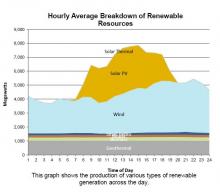
But the efficiency gains of electric traction are only half of the story for sustainable transport, since its not fully sustainable unless that electricity is generated in a sustainable way.
And when following online discussion of renewable energy at the Energy Collective, which attracts both advocates for and detractors of investment in renewable energy resources, a perennial source of ammunition for attacks on renewable energy are the challenges of meeting demand for electricity with the harvest of a variable source of energy that is available on its own schedule, and not ours.
This is a topic I have touched on before (cf , ), Inspired by the article at the Energy Collective: Will Natural Gas Peaker Plants Become Obsolete?, I am coming back to today. What I want to focus on today is the opportunities offered by dispatchable demand for better integration of variable renewable energy. And I would be happy if you would join me to discuss this topic (or any other topic involving sustainable transport), below the fold.

 Well, what do you know? I look around, and see a story saying
Well, what do you know? I look around, and see a story saying  This last week, in the comment section of the
This last week, in the comment section of the
Recent Comments